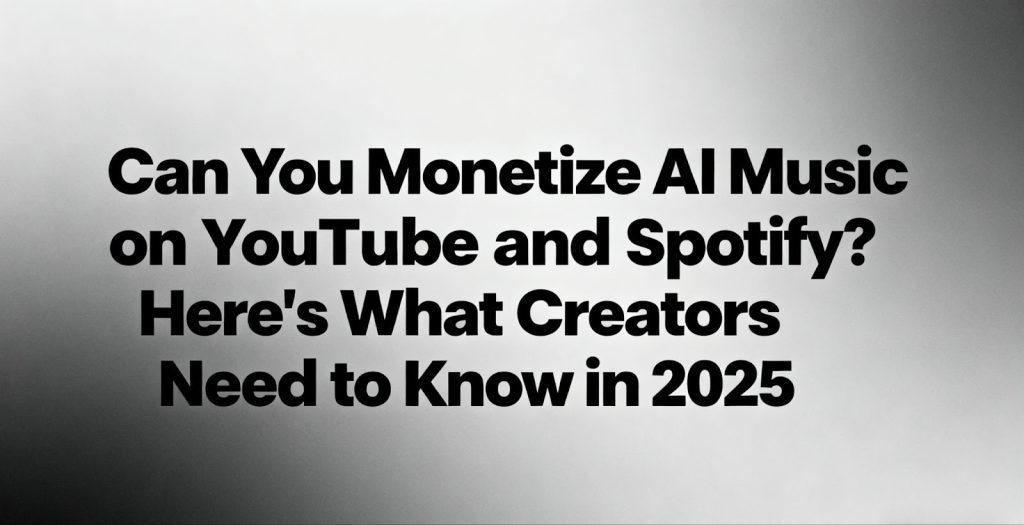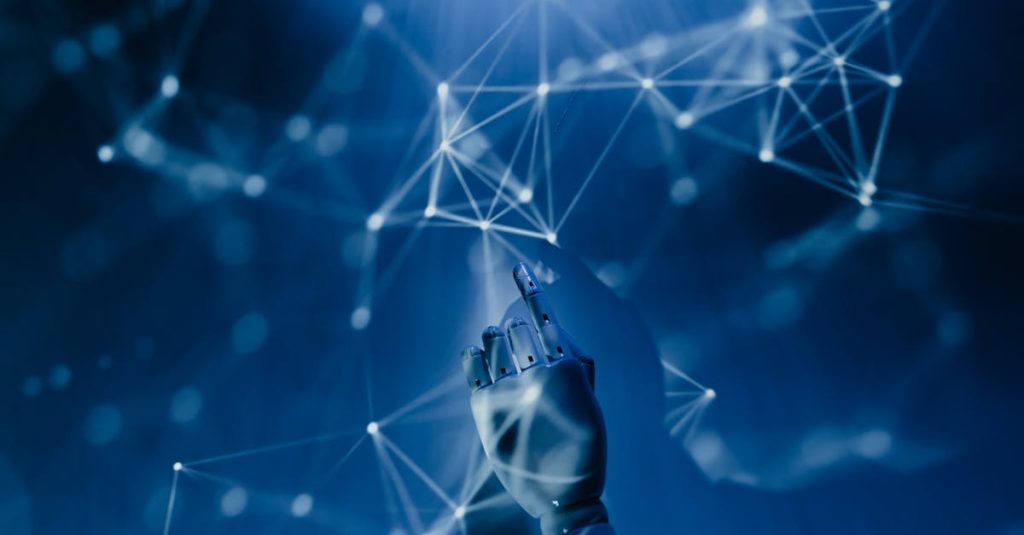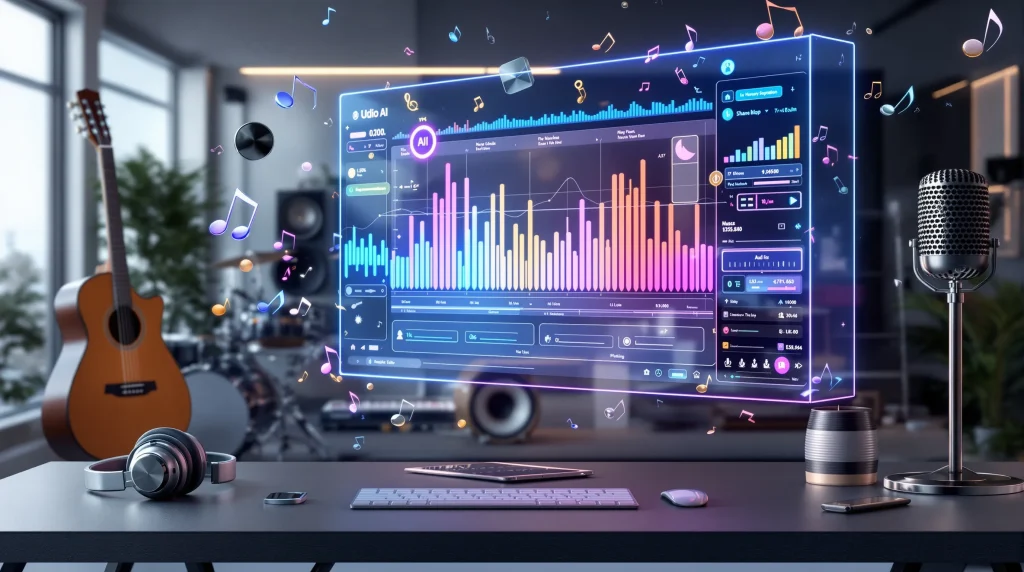Die Monetarisierung von KI-Musik hat sich für Musikschaffende, die nach neuen Einnahmequellen suchen, im Jahr 2025 zu einem entscheidenden Faktor entwickelt. Indem sie von Algorithmen komponierte Tracks in Streaming-Inhalte umwandeln, können Musiker Werbeeinnahmen, Abonnements und Tantiemen auf Plattformen erschließen. Dieser Leitfaden erklärt, wie man KI-Musik monetarisiert, sich mit den sich entwickelnden Richtlinien von YouTube und Spotify auseinandersetzt, Urheberrechts- und Rechtsfragen behandelt, Vertriebskanäle optimiert und ethische Standards einhält. Schöpfer erfahren, was KI-Musik ausmacht, warum führende Plattformen wichtig sind, die Feinheiten von Content ID und Streaming-Lizenzgebühren, Herausforderungen bei den Eigentumsverhältnissen, bewährte Vertriebsmethoden - einschließlich der Frage, wie Der KI-Musikgenerator von Mureka unterstützt jeden Schritt - und wichtige ethische Überlegungen. Ganz gleich, ob Sie Hobby- oder Profiproduzent sind - wenn Sie diese Elemente verstehen, können Sie KI-Kompositionen in nachhaltige Einnahmen umwandeln.
Was ist KI-Musik-Monetarisierung und warum ist sie im Jahr 2025 wichtig?
Die Monetarisierung von KI-Musik bezieht sich auf Einnahmen aus Kompositionen, die von Algorithmen des maschinellen Lernens generiert werden, und verwandelt kreativen Code in bezahlte Streams oder Werbeeinnahmen. Dieser Prozess nutzt KI-Kompositionstools, um Originaltitel zu produzieren, die auf Plattformen hochgeladen werden können, auf denen sich Hörer engagieren, was Zahlungen pro Abspielung oder Werbeeinblendung auslöst. Bis 2025 wird das schnelle Wachstum des KI-Musikmarktes - mit einer prognostizierten CAGR von über 20 Prozent - die automatisierte Komposition zu einer legitimen Einnahmequelle machen. Die Urheber profitieren von beschleunigten Produktionszyklen und minimalen Vorlaufkosten, was einen breiteren Katalog und diversifizierte Einnahmen ermöglicht. In dem Maße, in dem KI-Musik zum Mainstream wird, ist das Verständnis von Monetarisierungsrahmen entscheidend, um Rechte zu schützen, Einnahmen zu optimieren und in einer überfüllten Kreativwirtschaft die Nase vorn zu haben. Dieser Hintergrund bildet die Grundlage für plattformspezifische Richtlinien auf YouTube und Spotify, die bestimmen, wie die Einnahmen tatsächlich fließen.
Wie wird KI-Musik definiert und erstellt?
KI-Musik ist ein kreatives Werk, das von Algorithmen der künstlichen Intelligenz erzeugt wird, die Muster in bestehenden Kompositionen analysieren und neue Melodien, Rhythmen und Harmonien synthetisieren. Tools wie Der KI-Musikgenerator von Mureka verwenden neuronale Netze zur Interpretation von Stilparametern und zur Erstellung von Instrumentalstücken, die auf die Vorstellungen des Komponisten zugeschnitten sind. Dieser Mechanismus ermöglicht es Nutzern ohne formale Musikausbildung, durch die Auswahl von Genres, Tempi und Stimmungsvoreinstellungen einzigartige Tracks zu erstellen. Der Vorteil liegt in der Geschwindigkeit und der Anpassungsfähigkeit: KI-Engines können vollständige Kompositionen in wenigen Minuten erstellen, während integrierte Herausgeber Instrumentierung und Struktur zu verfeinern. Auf diese Weise erhalten Kreative die praktische Kontrolle über die Klangelemente und können Ideen schnell weiterentwickeln. Dieses grundlegende Verständnis der KI-gesteuerten Komposition führt natürlich dazu, dass YouTube und Spotify wichtige Orte für die Monetarisierung dieser Tracks sind.
Warum sind YouTube und Spotify Schlüsselplattformen für die KI-Musikvermarktung?
YouTube und Spotify dominieren den weltweiten Musikkonsum und kommen zusammen auf Milliarden von täglichen Streams. Das Werbeeinnahmemodell von YouTube und der Shorts-Fonds bieten den Urhebern direkte Auszahlungen auf der Grundlage von Ansichten und Engagement, während der abonnementbasierte Tantiemenpool von Spotify die Einnahmen pro Stream zuweist. Die kombinierte Reichweite stellt sicher, dass KI-generierte Musik ein großes Publikum erreichen und messbare Einnahmen generieren kann. Diese Plattformen fördern auch die Entdeckung durch Wiedergabelisten, algorithmische Empfehlungen und nutzergenerierte Inhalte, wodurch der Katalog eines Künstlers erweitert wird. Da sich die algorithmische Kuratierung weiterentwickelt, gewinnt KI-Musik, die mit den Vorlieben der Hörer übereinstimmt, an Bedeutung, so dass das Know-how der Plattformen für die Optimierung der Einnahmen entscheidend ist. Die Regeln jedes Dienstes zu verstehen, ist der nächste Schritt zur nahtlosen Monetarisierung.
Was sind die aktuellen Trends und das Marktwachstum in der KI-Musik?
KI-Musik hat sich von experimentellen Demos zur Mainstream-Produktion entwickelt, und immer mehr Musikschaffende integrieren generative Werkzeuge in ihre Arbeitsabläufe zu integrieren. Jüngste Branchenschätzungen gehen davon aus, dass der globale KI-Musiksektor jährlich um mehr als 20 Prozent wachsen wird, angetrieben von der Nachfrage nach lizenzfreien Hintergründen, Soundtracks und personalisierten Wiedergabelisten. Zu den wichtigsten Trends gehören der Anstieg der anpassbaren KI-Vokalsynthese, die adaptive Vertonung für interaktive Medien und Partnerschaften zwischen KI-Studios und großen Labels. Unabhängige Schöpfer nutzen Mikro-Lizenzierungsplattformen, um einzelne KI-Kompositionen für die kommerzielle Nutzung zu verkaufen. Mit zunehmender Verbreitung diversifizieren sich die Monetarisierungsmöglichkeiten - von Standard-Streaming-Ausschüttungen bis hin zu direkten Lizenzvereinbarungen - was die Bedeutung eines strategischen Vertriebs und der Einhaltung der sich entwickelnden Richtlinien auf YouTube und Spotify unterstreicht.
Was sind die KI-Musikrichtlinien und Monetarisierungsregeln von YouTube im Jahr 2025?
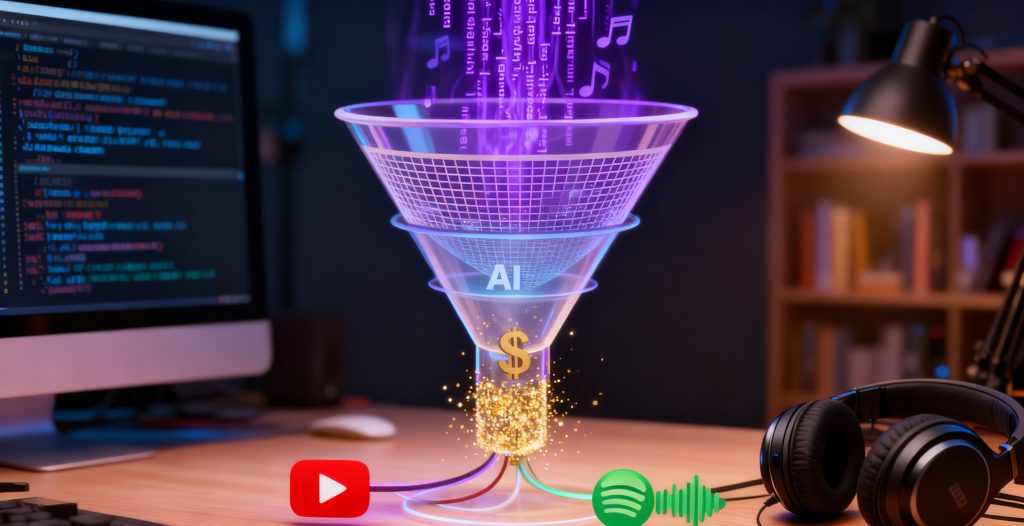
YouTube verlangt von Urhebern, dass sie KI-generierte Inhalte offenlegen, wenn diese das Vertrauen der Zuschauer beeinträchtigen. Dies steht im Einklang mit der allgemeinen Transparenzrichtlinie für KI-Inhalte, die im Oktober 2025 in Kraft tritt. Die Berechtigung zur Monetarisierung hängt von der Einhaltung von Community-Richtlinien, Urheberrechtsregeln und werbefreundlichen Standards ab. Die Kanäle müssen aktive Abonnements aufrechterhalten, Regelverstöße vermeiden und echtes Engagement zeigen. Erstens unterliegen KI-erstellte Tracks denselben Urheberrechtsbestimmungen wie alle von Nutzern hochgeladene Musik; zweitens kann die Transparenz über die KI-Nutzung die Genehmigung zur Monetarisierung beeinflussen; drittens bestimmen Interaktionen mit der Content ID die Aufteilung der Einnahmen, wenn sie automatisch mit bestehenden Werken abgeglichen werden. Diese Kriterien bestimmen, wie Urheber Uploads, Metadaten und Offenlegungen planen, und bilden eine Brücke zu den Besonderheiten der KI-Regulierung auf YouTube.
Wie definiert und reguliert YouTube KI-generierte Musikinhalte?
YouTube stuft KI-generierte Musik als Originalinhalt ein, wenn keine urheberrechtlich geschützten Melodien oder Samples verwendet werden. Die Schöpfer müssen bestätigen, dass sie Eigentümer oder ordnungsgemäß lizenziert sind, wenn sie KI-Systeme mit Quellmaterial versorgen. Diese Regelung stellt sicher, dass automatisierte Kompositionen für die Monetarisierung in Frage kommen und nicht zu Urheberrechtsansprüchen führen. Die Transparenz wird durch einen klaren Hinweis in der Videobeschreibung oder den Metadaten auf die KI-Generierung gewährleistet. Durch die Behandlung von KI-Tracks als CreativeWork-Entitäten im Sinne des Urheberrechts erhält YouTube einen einheitlichen rechtlichen Rahmen. Das Verständnis dieser Definition ebnet den Weg für Überlegungen zur Content-ID.
Was ist Content ID und wie wirkt es sich auf die Monetarisierung von AI-Musik auf YouTube aus?
Content ID ist das automatische System von YouTube, das Uploads auf Übereinstimmungen mit einer Datenbank urheberrechtlich geschützter Audiodateien überprüft. Wenn KI-generierte Musik versehentlich bestehenden Werken ähnelt, kann Content ID alle oder einen Teil der Einnahmen einfordern. Um dies zu vermeiden, sollten Urheber ihre KI-Originalkompositionen bei einer anerkannten Rechteverwertungsgesellschaft registrieren lassen oder sie an die YouTube-eigene Referenzbibliothek übermitteln. Durch die proaktive Verwaltung der Eigentums-Metadaten behalten die Künstler die volle Monetarisierung, anstatt Einnahmen an die entsprechenden Rechteinhaber zu verlieren.
Diese Anforderungen machen deutlich, wie sich das Content-ID-Management direkt auf die Umsatzströme auswirkt und zur Monetarisierung über verschiedene YouTube-Formate führt.
Tabelle: Vergleich der KI-Richtlinien von YouTube
| Politischer Aspekt | YouTube-Anforderung | Schöpfer Aktion |
|---|---|---|
| Offenlegung | KI-generierter Status in Metadaten deklarieren | Fügen Sie eine klare AI-Anweisung pro Upload hinzu |
| Copyright-Registrierung | Registrierung neuer Kompositionen bei einer Rechteinrichtung | Spuren an die Content-ID-Referenz senden |
| Zulässigkeit der Anzeige | Erfüllen Sie die Gemeinschaftsrichtlinien und Anzeigenstandards | Überprüfen Sie die Anzeigenrichtlinie vor der Einrichtung der Monetarisierung |
Können Sie AI-Musik in YouTube-Kurzfilmen und anderen Formaten vermarkten?
Ja, sowohl kurze als auch lange YouTube-Videos unterstützen KI-generierte Titel, sofern die Richtlinien eingehalten werden. Die Monetarisierung von Kurzfilmen basiert auf dem Kurzfilm-Fonds und den Zuschauerstatistiken und nicht auf Standard-Werbeunterbrechungen, was eine konstante Anzahl von Zuschauern und eine Zuschauerbindung über den Schwellenwerten der Plattform voraussetzt. Langform-Videos folgen der traditionellen Aufteilung der Werbeeinnahmen, mit mehreren Werbeblöcken pro Video. Playlists, Premieren und Community-Posts mit KI-Musik können die Gesamtbeteiligung am Kanal weiter steigern und so die Gesamteinnahmen erhöhen. Ersteller sollten die Videolänge optimieren, KI-Bestätigungen einbeziehen und die Formate diversifizieren, um das Verdienstpotenzial für alle YouTube-Angebote zu maximieren.
Was sind die Offenlegungspflichten für KI-Musik auf YouTube?
YouTube schreibt vor, dass jeder Einsatz von KI zur Erzeugung oder Veränderung von Musik in der Beschreibung oder den Metadaten vermerkt werden muss. Diese Transparenzanforderung verhindert eine Irreführung des Publikums und steht im Einklang mit den allgemeinen Vorschriften für digitale Inhalte. Durch Angaben wie “Track generiert mit einem KI-Musikgenerator” wird die Einhaltung der Vorschriften sichergestellt. Eine klare Offenlegung schafft Vertrauen und unterstützt die Monetarisierungsfähigkeit, während ein Verzicht darauf die Gefahr birgt, dass die Inhalte entwertet oder von der Politik gestrichen werden. Das Verständnis dieser Verpflichtungen unterstreicht die Notwendigkeit einer einheitlichen Kennzeichnungspraxis.
Wie handhabt Spotify die KI-Musiklizenzgebühren und den Vertrieb im Jahr 2025?
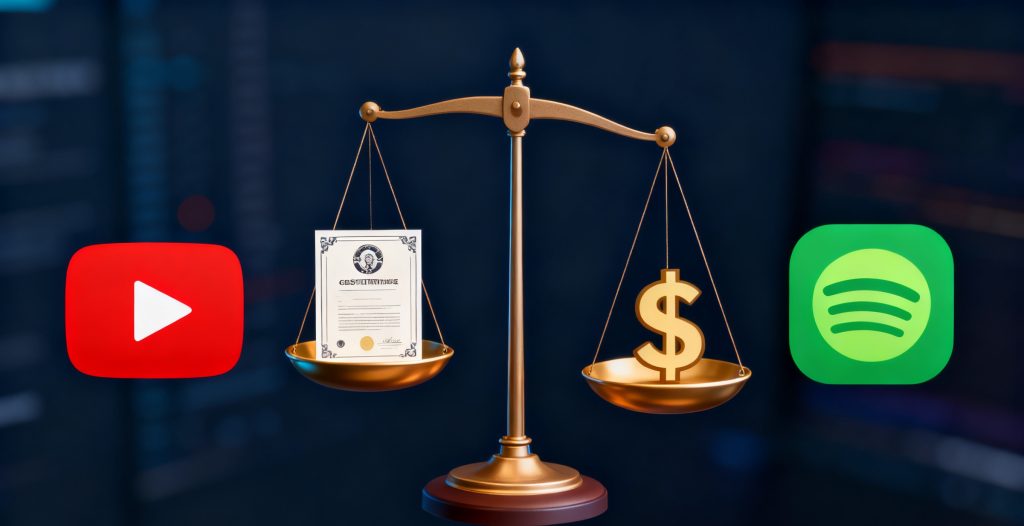
Spotify behandelt KI-generierte Tracks wie jede andere Aufnahme und leitet die Tantiemen über sein Streamshare-Modell weiter, das die Mittel aus Abonnenten- und Werbeeinnahmen auf der Grundlage der Track-Performance zuweist. Durch das Hochladen über zugelassene Distributoren stellen die Urheber sicher, dass sie Tantiemen erhalten und in algorithmischen Playlists platziert werden. Die Richtlinien der Plattform betonen die Originalität: KI-Tracks dürfen keine urheberrechtlich geschützten Melodien imitieren, und die Metadaten müssen die Urheberschaft genau wiedergeben. Diese Regeln ermöglichen eine faire Vergütung und schützen vor betrügerischem Streaming - oft auch als “Rauschen” bezeichnet. Die Beherrschung von Best Practices zu Spotify-Tantiemenstrukturen ist für ein nachhaltiges Einkommen unerlässlich und führt zu den Details der Tantiemenmechanik.
Wie geht Spotify mit KI-generierten Tracks und Streaming um?
Spotify definiert KI-generierte Aufnahmen als gültige MusicRecording-Entitäten, wenn die Kriterien für die Originalkomposition erfüllt sind. Das Content-Ingestion-System der Plattform überprüft die Richtigkeit der Metadaten und erkennt verdächtige Streaming-Spitzen, die auf ein nicht authentisches Verhalten hindeuten. Durch die Konzentration auf echte Hörerbindung hält Spotify eine Qualitätsschwelle ein, die Störgeräusche herausfiltert und sicherstellt, dass KI-gesteuerte Werke fair vergütet werden. Dieser Ansatz schafft ein Gleichgewicht zwischen Innovation und Vertrauen und ermutigt die Urheber, konforme, qualitativ hochwertige Titel zu produzieren. Das Verständnis dieser Gestaltungsprinzipien schafft die Voraussetzungen für die Erzielung von Tantiemen.
Wie können Schöpfer von AI-Musik auf Spotify Tantiemen verdienen?
Schöpfer verdienen Tantiemen durch ein anteiliges Verteilungsmodell, bei dem die Gesamtzahl der Streams einen Anteil am Streaming-Tantiemenpool bestimmt. Die Aufteilung der Einnahmen wird über digitale Vertriebspartner verwaltet, die die Auszahlungen auf der Grundlage von Leistungsdaten weiterleiten. Zu den wichtigsten Schritten gehören die Registrierung von Kompositionen bei einer Organisation für Aufführungsrechte, die Kennzeichnung von Aufnahmen mit genauen Angaben zu Interpreten und Komponisten sowie die Auswahl eines Vertriebs, der KI-generierte Inhalte unterstützt. Durch die Abstimmung von Metadaten und Registrierung maximieren die Urheber die Auszahlungen pro Stream und sichern sich eine transparente Nachverfolgung der Tantiemen.
Was sind die besten Praktiken zur Vermeidung von Richtlinienverstößen und ‘Lärm’ auf Spotify?
Um die Einhaltung der Vorschriften zu gewährleisten und Streaming-Rauschen zu vermeiden, sollten die Urheber dies tun:
- Aufbau einer organischen Hörerbasis durch Playlist-Pitching und Social Promotion.
- Stellen Sie sicher, dass die KI-Kompositionen hinreichend einzigartig sind und nicht von bestehenden urheberrechtlich geschützten Werken abgeleitet sind.
- Überwachen Sie Streaming-Analysen auf unregelmäßige Spitzen und gehen Sie auf verdächtige Aktivitäten ein.
- Aktualisieren Sie die Metadaten konsequent, um die tatsächliche Autorenschaft und das Veröffentlichungsdatum wiederzugeben.
Diese proaktiven Maßnahmen schützen das Ansehen der Konten und unterstützen einen zuverlässigen Fluss von Lizenzgebühren, der die Urheber zu den im Folgenden untersuchten Vertriebsentscheidungen führt.
Wie wirkt sich der Vertrieb auf die Monetarisierung von AI-Musik auf Spotify aus?
Durch den Vertrieb über etablierte Aggregatoren werden KI-Tracks in MusicRecording-Assets umgewandelt, die Spotify für die Zuweisung von Tantiemen anerkennt. Aggregatoren kümmern sich um die Einreichung von Playlisten, die Validierung von Metadaten und die Freigabe von Rechten. Die Wahl eines Vertriebspartners mit KI-freundlichen Richtlinien gewährleistet eine nahtlose Auslieferung und eine genaue Berichterstattung über die Einnahmen. Ein effizienter Vertrieb wirkt sich direkt auf die Sichtbarkeit der Wiedergabelisten aus, was wiederum die Streams erhöht und die Tantiemen steigert. Dieser Zusammenhang zwischen der Qualität des Vertriebs und dem Erfolg der Monetarisierung führt zu Fragen der rechtlichen Eigentumsverhältnisse für KI-Musik.
Wem gehört die AI-Musik? Urheberrecht und rechtliche Fragen für Kreative verstehen
Das Urheberrecht für KI-Musik hängt von der menschlichen Urheberschaft und der Originalität der Kompositionsbeiträge ab. Wenn ein Urheber KI-Tools zum Arrangieren, Bearbeiten oder Leiten der kreativen Richtung eines Titels verwendet, besitzt er das Urheberrecht als menschlicher Urheber. Rein unbeaufsichtigte algorithmische Ergebnisse ohne sinnvolle menschliche Eingaben bleiben außerhalb des typischen Urheberrechtsschutzes. Vor der Vermarktung von KI-Kompositionen ist es von entscheidender Bedeutung, sich mit diesen Eigentumsregeln auseinanderzusetzen. Klare Urheberrechtsansprüche und Registrierungspraktiken schützen Einnahmequellen und vermeiden Rechtsstreitigkeiten. Diese rechtlichen Grundlagen fließen direkt in die nächsten Abschnitte über die Registrierung und den Schutz von KI-Musik ein.
Kann KI-generierte Musik im Jahr 2025 urheberrechtlich geschützt werden?
Ja, KI-generierte Musik kann urheberrechtlich geschützt werden, wenn ein ausreichender menschlicher kreativer Eingriff vorliegt. Die Urheberrechtsämter in den wichtigsten Ländern verlangen jetzt einen nachweisbaren Beitrag, z. B. die Auswahl stilistischer Parameter, die Bearbeitung von Arrangements oder die Verfeinerung von Kompositionen mit einem KI-Editor. Dieses Erfordernis der menschlichen Mitwirkung stellt sicher, dass dem Werk die ursprüngliche Urheberschaft zugrunde liegt. Die Produzenten müssen ihre kreativen Entscheidungen dokumentieren und Aufzeichnungen über KI-Eingaben und Bearbeitungssitzungen führen. Diese Praktiken ebnen den Weg für eine formale Registrierung.
Wer hält das Urheberrecht für KI-Musik, die mit Tools wie Mureka erstellt wurde?
Schöpfer, die die Der KI-Musikgenerator von Mureka um Melodien zu formen, die Instrumentierung anzupassen und Kompositionen zu vollenden, werden als Urheber dieser Werke betrachtet. Durch die Anwendung persönlicher künstlerischer Entscheidungen - Auswahl des Genres, Anpassung des Tempos und strukturelle Änderungen - erfüllen sie die Schwelle zur Urheberschaft. Mureka fungiert als Tool-Anbieter, während der Urheber die ausschließlichen Rechte an dem Titel behält. Durch die korrekte Zuordnung der Metadaten und die Registrierung der Rechte wird sichergestellt, dass alle Tantiemen an den menschlichen Urheber und nicht an die Plattform fließen.
Wie lassen sich Urheberrechtsregistrierung und faire Nutzung auf KI-Musik anwenden?
Bei der Registrierung von KI-Kompositionen müssen die fertigen Werke zusammen mit den Aufzeichnungen über die kreativen Beiträge bei der zuständigen Urheberrechtsbehörde eingereicht werden. Die Registrierung begründet einen Rechtsanspruch und vereinfacht die Einziehung von Tantiemen durch Organisationen für Aufführungsrechte. Die Grundsätze der fairen Nutzung können ein begrenztes Sampling von KI-Musik in umgestaltenden Werken - wie Remixen oder pädagogischen Analysen - erlauben, sofern das neue Material einen bedeutenden originellen Kommentar oder Zweck hinzufügt. Schöpfer sollten bei der Planung abgeleiteter Projekte die allgemeinen Richtlinien zur fairen Nutzung zu Rate ziehen, um Verstöße zu vermeiden.
Was sind die wichtigsten rechtlichen Risiken und wie können die Urheber ihre KI-Musik schützen?
Zu den Hauptrisiken gehören die unbeabsichtigte Ähnlichkeit mit bestehenden urheberrechtlich geschützten Werken, die unbefugte Entnahme von Beiträgen Dritter und Streitigkeiten über die Schwellenwerte für die Urheberschaft. Um diese Risiken zu minimieren, sollten die Urheber:
- Dokumentieren Sie alle kreativen Vorgaben und Bearbeitungen, die Sie in den KI-Tools vornehmen.
- Verwenden Sie nur lizenziertes Quellmaterial oder Open-Source-Daten für das KI-Training.
- Registrieren Sie die fertigen Titel bei den offiziellen Urheberrechtsämtern.
- Sichern Sie sich schriftliche Vereinbarungen, wenn Sie mit anderen Urhebern oder KI-Entwicklern zusammenarbeiten.
Durch die Einhaltung dieser Sicherheitsvorkehrungen werden die Verwertungsrechte gewahrt und die Gefahr rechtlicher Anfechtungen verringert.
Wie können Musikschaffende KI-Musik verbreiten, um die Monetarisierung auf YouTube und Spotify zu maximieren?
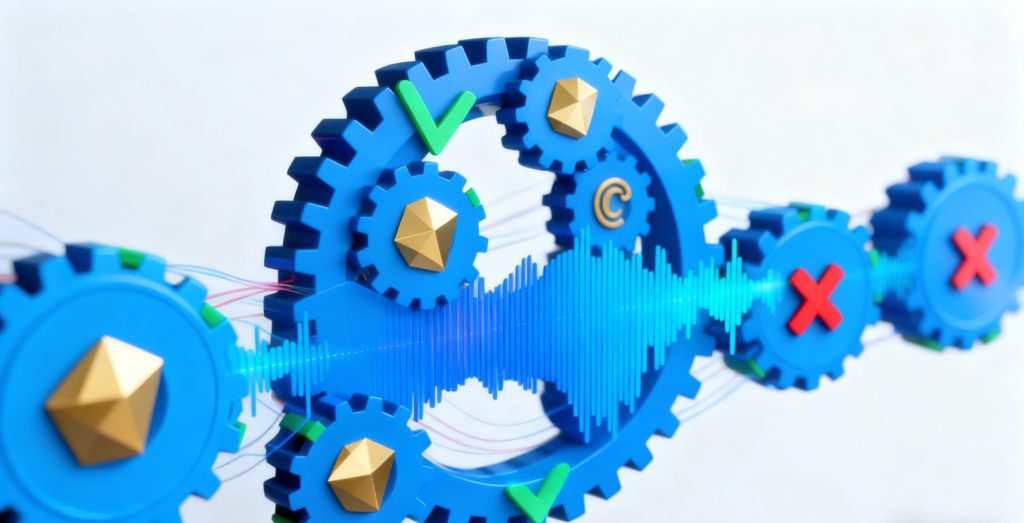
Ein effektiver Vertrieb verbindet KI-Tracks mit den Lizenzsystemen von Plattformen, Playlist-Algorithmen und Lizenzierungsmöglichkeiten. Durch die Auswahl digitaler Aggregatoren, die KI-generierte Inhalte unterstützen, können Urheber die Integrität von Metadaten, die Freigabe von Rechten und die Erstellung von Wiedergabelisten sicherstellen. Die ordnungsgemäße Aufbereitung von Audiodateien, Cuesheets und Artwork verbessert die Auffindbarkeit. Diese Vertriebsschritte bilden das Rückgrat der Monetarisierung und führen zu spezifischen Vertriebsvergleichen.
Welches sind die wichtigsten digitalen Vertriebskanäle für KI-Musik im Jahr 2025?
Zahlreiche Aggregatoren kümmern sich um KI-basierte Urheber, indem sie die Validierung von Metadaten, die Rechteverwaltung und die Bereitstellung auf der Plattform übernehmen. Zu den beliebten Optionen gehören:
- DistroKid: Schnelle Uploads und anpassbare Umsatzaufteilung.
- TuneCore: Umfassende Rechteverwaltung und Berichterstattung.
- CD Baby: Globale Veröffentlichung und Unterstützung bei der Synchronisierung von Lizenzen.
Diese Dienste optimieren die Übermittlung an YouTube, Spotify und andere Plattformen und ziehen gleichzeitig Tantiemen ein. Die Wahl des richtigen Vertriebs wirkt sich auf die Transparenz der Einnahmen und die Geschwindigkeit der Auszahlung aus.
Wie kann man AI-Musik für Streaming-Plattformen vorbereiten und einreichen?
Vor der Einreichung müssen die Ersteller:
- Exportieren Sie Spuren in für die Plattform geeignete Formate (z. B. 16-Bit-WAV).
- Vollständige Metadatenfelder: Titel, Künstlername, Komponistennachweis.
- Generieren Sie wellenformgenaue Vorschaubilder für Konformitätsprüfungen.
- Hochladen auf einen ausgewählten Aggregator mit Rechtedokumentation.
Gut vorbereitete Einreichungen minimieren Verzögerungen und gewährleisten eine genaue Nachverfolgung der Lizenzgebühren, was die Voraussetzungen für eine Lizenzierung über das Streaming hinaus schafft.
Welche Möglichkeiten der Lizenzierung und Synchronisierung gibt es über das Streaming hinaus?
AI-Kompositionen können ein zusätzliches Einkommen erzielen:
- Sync-Lizenzierung für Film, Fernsehen und Videospiele.
- Hintergrundmusik-Abonnements für Inhaltsersteller.
- Werbe- und Markenpartnerschaften, die KI-Bewertungen enthalten.
Diese Möglichkeiten ergänzen die Streaming-Lizenzgebühren und diversifizieren die Einnahmen. Zu einem soliden Vertriebsansatz gehört auch, dass Tracks als Teil einer ganzheitlichen Monetarisierungsstrategie für Synchronisierungsmöglichkeiten angeboten werden.
Wie unterstützt Mureka Musikschaffende von der KI-Musikkreation bis zur Monetarisierung?
Der KI-Musikgenerator von Mureka befähigt Schöpfer mit intuitive Kompositionswerkzeuge, anpassbare Vorlagen und einen integrierten Editor für die Verfeinerung von Instrumentalstücken. Durch die Bereitstellung von qualitativ hochwertigen Stems und Exportoptionen gewährleistet Mureka die Kompatibilität mit den Anforderungen des Vertriebs. Die Plattform führt die Nutzer durch die Namenskonventionen und Best Practices für Metadaten und überbrückt so die Lücke zwischen der kreativen Erstellung und der Bereitstellung auf der Plattform. Diese durchgängige Unterstützung vereinfacht den Weg von der ersten Idee bis zur Monetarisierung auf YouTube und Spotify. Erkundung beginnen AI-Musik heute und erschließen Sie neue Einnahmequellen mit fundierten, rechtskonformen Strategien.
Welche ethischen Erwägungen sollten KI-Musikschaffende im Jahr 2025 kennen?
KI-Musik wirft ethische Fragen auf, die sich auf die gerechte Entlohnung menschlicher Künstler, die Transparenz der Herkunft von Inhalten und den möglichen Missbrauch von Deepfake-Vocals beziehen. Die Schöpfer müssen ein Gleichgewicht zwischen Innovation und Respekt für bestehende Musikgemeinschaften finden und sicherstellen, dass KI-Ergänzungen nicht die nicht anerkannte menschliche Arbeit ausnutzen. Die Einhaltung ethischer Standards stärkt das Vertrauen des Publikums und unterstützt die Nachhaltigkeit der Branche, was sich konkret auf die faire Vergütung auswirkt.
Wie wirkt sich KI-Musik auf menschliche Künstler und faire Entlohnung aus?
KI-Kompositionswerkzeuge können das Musikschaffen demokratisieren, bergen aber auch die Gefahr, dass die menschliche Kunst entwertet wird, wenn Algorithmen menschliche Komponisten ohne angemessene Anerkennung oder Bezahlung ersetzen. Zu einer ethischen Nutzung gehören die Nennung der Inspirationsquellen, die Aufteilung der Einnahmen, wenn KI-Modelle von Künstlern zur Verfügung gestellte Daten einbeziehen, und das Eintreten für Industriestandards, die die ursprünglichen Schöpfer belohnen. Transparente Vergütungsregelungen stellen sicher, dass sowohl die Entwickler von KI-Tools als auch die menschlichen Mitwirkenden einen fairen Anteil erhalten, und stärken so das kreative Ökosystem.
Was sind die Best Practices für Transparenz und Offenlegung von KI-Musik?
Schöpfer sollten KI-generierte Werke in Beschreibungen, Metadaten und Werbematerialien eindeutig kennzeichnen. Praktiken der Offenlegung umfassen:
- Angabe von “Komponiert mit KI-Unterstützung” im Abspann.
- Erläuterung der Rolle der KI im Vergleich zum menschlichen Input.
- Dokumentation von kreativen Vorschlägen und Bearbeitungen.
Diese Maßnahmen fördern das Vertrauen und entsprechen den neuen Vorschriften zur Transparenz von KI-Inhalten.
Wie werden Deepfakes und Betrugsprobleme in der KI-Musik angegangen?
Aufkommende Standards erfordern Authentifizierungsprotokolle, wie z. B. das Anbringen von Wasserzeichen bei KI-generierten Audiodaten, um synthetischen Gesang von echten Darbietungen zu unterscheiden. Brancheninitiativen entwickeln Richtlinien zur Erkennung und Unterbindung von Deepfake-Missbrauch bei der unerlaubten Nachahmung berühmter Künstler. Durch die Einführung von Verifizierungswerkzeugen und die Unterstützung rechtlicher Rahmenbedingungen, die betrügerische KI-Inhalte bestrafen, können Musikschaffende dazu beitragen, die Integrität sowohl der KI als auch des menschlichen musikalischen Ausdrucks zu schützen.
Was sind die häufigsten Fragen zur Monetarisierung von AI-Musik auf YouTube und Spotify?
Kann man mit KI-generierter Musik auf YouTube und Spotify Geld verdienen?
Ja, Urheber können KI-generierte Musik auf beiden Plattformen monetarisieren, sofern sie die Richtlinien der einzelnen Dienste in Bezug auf Originalität, Offenlegung und Urheberrechtsregistrierung einhalten. Sobald die KI-Kompositionen die Qualitäts- und Transparenzanforderungen erfüllen, sind Werbeeinnahmen, Shorts-Auszahlungen und Streaming-Tantiemen möglich.
Wie erhält man Tantiemen für AI-Musik auf Streaming-Plattformen?
Die Tantiemen werden über digitale Aggregatoren eingezogen, die die Titel an die Plattformen weitergeben und die Einnahmen auf der Grundlage der Anzahl der Abspielungen und der Abonnement-Pools weiterleiten. Die Urheber müssen ihre Kompositionen bei den Organisationen für Aufführungsrechte registrieren lassen und für genaue Metadaten sorgen, um die vollen Tantiemen zu erhalten.
Was sind die Regeln für das Hochladen von AI-Musik auf Spotify und YouTube?
Beide Plattformen verlangen, dass KI-generierte Musik ein Original ist und nicht von bestehenden urheberrechtlich geschützten Werken abgeleitet wird. Die Metadaten müssen die wahre Urheberschaft widerspiegeln, und jede Verwendung von KI-Tools muss in den Videobeschreibungen oder im Abspann des Titels angegeben werden. Die Einhaltung von Community- und Werberichtlinien ist für die Monetarisierung ebenfalls unerlässlich.
Wie können Schöpfer sicherstellen, dass ihre KI-Musik für die Vermarktung in Frage kommt?
Schöpfer sollten ihren kreativen Beitrag dokumentieren, ihre Werke bei den Urheberrechtsbehörden registrieren, KI-freundliche Händler auswählen, die KI-Nutzung klar kennzeichnen und die Richtlinien der Plattformen zu Originalität und Transparenz einhalten. Diese Schritte garantieren die Berechtigung und schützen künftige Einnahmequellen.
Die Monetarisierung von KI-Musik auf YouTube und Spotify bietet Künstlern die Möglichkeit, algorithmische Kompositionen in nachhaltige Einnahmen zu verwandeln. Durch die Beherrschung der Plattformrichtlinien, die Verwaltung von Urheberrechten und Tantiemen, die Wahl der richtigen Vertriebskanäle und die Einhaltung ethischer Standards können Künstler ihre Einnahmen in der sich entwickelnden Landschaft des Jahres 2025 maximieren. Umarmung KI-Tools wie der Generator von Mureka ermöglicht es Musikschaffenden, qualitativ hochwertige Tracks zu produzieren, Workflows zu optimieren und den Weg von der Erstellung bis zur Vermarktung sicher zu beschreiten. Beginnen Sie noch heute mit der Erkundung von KI-Musik und erschließen Sie neue Einnahmequellen mit fundierten, rechtskonformen Strategien.

